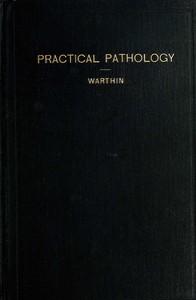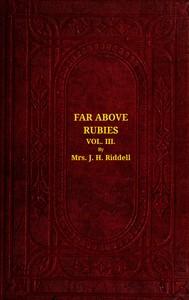|
|
Read this ebook for free! No credit card needed, absolutely nothing to pay.Words: 133185 in 50 pages
This is an ebook sharing website. You can read the uploaded ebooks for free here. No credit cards needed, nothing to pay. If you want to own a digital copy of the ebook, or want to read offline with your favorite ebook-reader, then you can choose to buy and download the ebook.

: Practical pathology by Warthin Aldred Scott - Autopsy; Pathology Laboratory manuals@FreeBooksFri 22 Sep, 2023 THE SOURCES OF PATHOLOGIC MATERIAL AND THE METHODS OF OBTAINING IT FOR EXAMINATION. THE TREATMENT OF THE MATERIAL. FIGURE PAGE SOURCES OF PATHOLOGIC MATERIAL AND METHODS OF OBTAINING IT FOR EXAMINATION. INTRODUCTION. The chief sources of pathologic material are the autopsy, surgical operation, diagnostic excision and curetting, the spontaneous discharge of diseased tissue, and the experimental production of pathologic conditions in animals. To these sources may be added the blood and other body-fluids, as well as pathologic fluids, exudates, effusions, cyst-contents, etc., particularly the cellular elements found in the sediment of such fluids. That an accurate pathologic diagnosis be secured, the material must first be properly obtained, its gross characteristics carefully noted, the portion to be examined microscopically chosen with discrimination, and, finally, the microscopic examination itself carried out along the various lines indicated. All of these procedures require the knowledge of a certain amount of technique, and the general principles of such technique should be familiar to every student of medicine. While it is not possible that every medical graduate can enter into the active practice of his profession as an expert pathologist, yet the possession of the technical knowledge necessary to perform an autopsy properly and to select with discrimination the tissue for microscopic examination gives to a physician a distinct practical advantage. This advantage becomes the greater if to the possession of this knowledge there be added also a practical working knowledge of the technique necessary for the microscopic examination and diagnosis. Not that this knowledge should be so extensive as to cover the great field of special methods; all that is really essential is a knowledge of the general principles of laboratory examinations; and a very large proportion of practical work can be successfully carried out if the physician possesses this foundation knowledge. In the first days of practice a young physician so equipped often finds that his laboratory training comes to be his chief source of income and opens the way to a successful professional career. It constitutes a professional asset which the older practitioner usually does not possess. THE AUTOPSY: GENERAL CONSIDERATIONS. Primarily, the aim of the autopsy is to ascertain the cause of death and to acquire knowledge of the changes produced in the tissues and organs by the disease-process. If for no other purpose than that of extending our knowledge of disease, the autopsy becomes the most valuable factor in furthering the development of medical science. We have but entered into the broad, rich fields of pathology; at any time new facts may be discovered or observations of the most far-reaching nature made. From year to year the statistics of the most common diseases must be revised in the light of new conceptions of disease. Through the autopsy there lies within the reach of every practitioner the opportunity of contributing something worth while to the general sum of medical knowledge. There is not a pathologic condition in the medical category that does not call out for illumination upon some point or other. The phenomena of malignant tumors, the earliest stages of the so-called chronic affections, as well as the majority of the infectious diseases, require further autopsy observations for their elucidation. The autopsy establishment of the diagnosis is also of the greatest importance in giving value to vital statistics. Until we have a more universal confirmation of the clinical diagnosis by the pathologic our vital statistics must of necessity be imperfect. To the practitioner the autopsy offers further a most valuable control of subjectivity and a guide to methods of diagnosis and treatment. Without such a control no one is so likely to get into a dangerous rut as the practicing physician. The disclosures of the autopsy will enable him to correct faulty methods, and should effectually check any tendency to superficial diagnosis. Particularly is this the case with regard to such diagnostic methods as palpation, percussion and auscultation. Postmortem percussion offers a most valuable means of acquiring precision in this important branch of physical diagnosis. The percussion boundaries may be marked upon the body by pencil, or long pins may be inserted, so that when the body is opened the exact relation of the percussion area to the organ in question may be noted. In the case of palpable tumors the results of palpation before the body is opened should be carefully controlled by the findings when the actual conditions are exposed. Even when the cause of death seems obvious it is worth while to perform an autopsy at every opportunity offered, both for the sake of controlling technical methods and for the pictures of disease revealed. More accurate knowledge of the nature of the processes of disease can be obtained through one autopsy than through months of textbook reading. To the surgeon the opportunity of examining cases dying after surgical operation should be a source of great satisfaction. The review of anatomic relationships offered by the autopsy is in itself worth while, and in the case of healthy individuals killed by accident the survey of the normal appearances of the organs and tissues offers an opportunity for study too valuable to be neglected. Further, it is justifiable to practice upon the cadaver any surgical operation that does not disfigure it. Removal of the spleen, transplantation of thyroid tissue into the spleen, decapsulation of the kidney, transplantation of ovarian tissue, gastric and intestinal operations, anastomosis of blood-vessels, operations upon the uterus and cervix, prostate, vas deferens, thyroid, nose, ear, etc., and many other surgical procedures may be practiced with profit upon a cadaver during the course of an autopsy. The feasibility of a new operative method or the improvement of an old one may thus be demonstrated. In the case of medicolegal autopsies the ends of justice as well as the life, liberty or reputation of some individual may depend upon the results of the postmortem examination. In all cases to which there is any suspicion attached, or in which the cause or manner of death is doubtful an autopsy should be legally required, but unfortunately this is not yet done in this country. Physicians individually should endeavor to create in the public mind a more healthy attitude toward the autopsy and an appreciation of its usefulness. As to his own share in the advantages derived from it, it is safe to say that no physician can perform an autopsy properly without having his experience widened, his knowledge of disease increased, his diagnostic faculties sharpened and his tendency to subjectivity controlled. Last, but far from being the least, should be his gain in honesty and humility. A physician who performs an autopsy without the consent of the person having the custody of the deceased does so at his own risk, except in those cases in which the autopsy is in accordance with legal statutes. In the majority of the States there are statutes providing that the Coroner or Board of Health shall order an autopsy whenever a person is found dead and the cause of his death is not apparent, and cannot be ascertained from the evidence given, or from a superficial examination of the body. In such cases no permit from the relatives is necessary, and an autopsy performed under the direction of law is never subject to legal punishment, if it has been performed according to approved methods. Nevertheless, even in these cases it is a better policy to secure the consent of the custodian of the body, when this is possible. Free books android app tbrJar TBR JAR Read Free books online gutenberg More posts by @FreeBooks
|
Terms of Use Stock Market News! © gutenberg.org.in2025 All Rights reserved.






